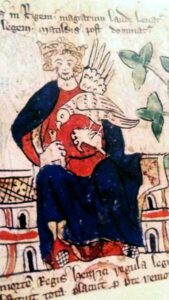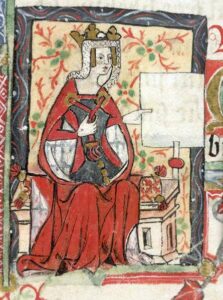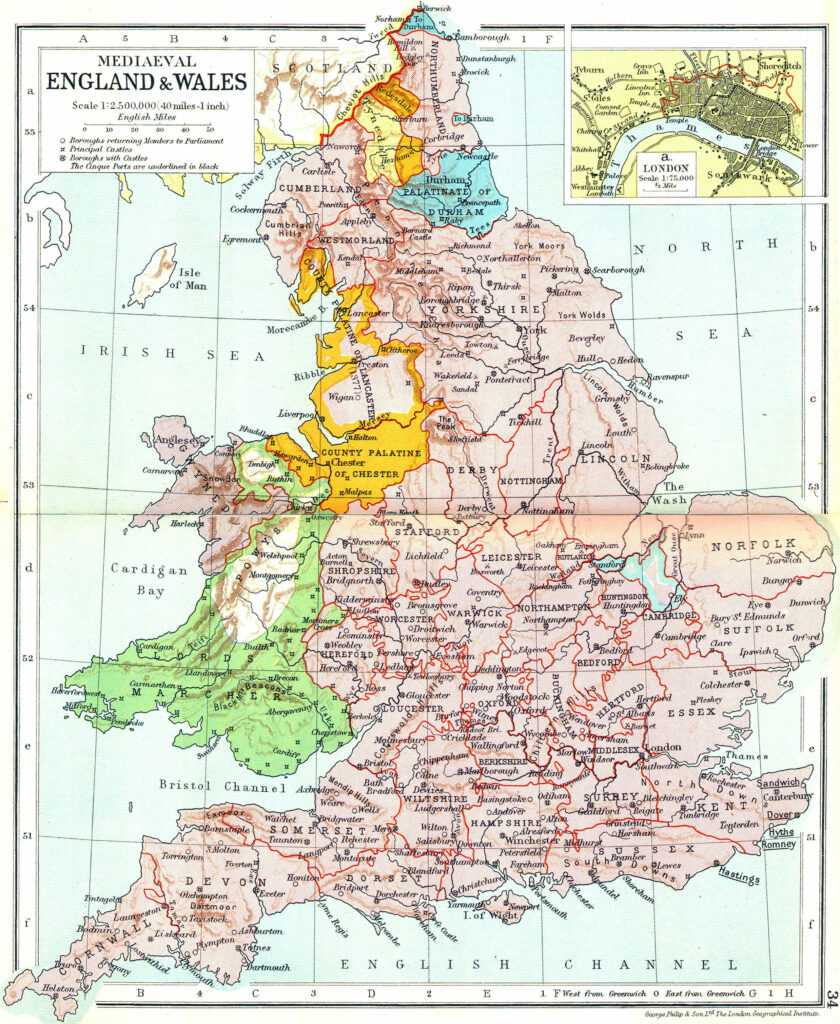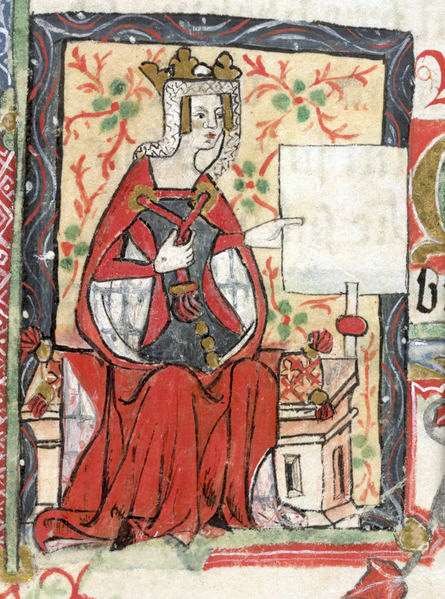The year is 1153. Tensions are high as England is collapsing from the stress of a civil war, and the entire nation is desperate for a solution. Matilda sits before Stephen I with her son Henry by her side, and the three negotiate and draft the Treaty of Wallingford. This treaty would allow Stephen to remain king, but Matilda’s son, Henry, would be crowned king after Stephen’s death. After fifteen years of war between Stephen and Matilda, a compromise had finally been reached. The compromise was easily accepted by many as England’s economy and people had suffered greatly from the war. This agreement also settled the question of the future heir to the throne. With the establishment of this treaty, Matilda’s son Henry would be the first king from the House of Plantagenet to ascend the throne, ending the line of Norman kingship. The rise of the Plantagenet family and Henry was not by chance but by the mistreatment of one woman, Empress Matilda, the rightful heir to the English throne and former Holy Roman Empress. After the death of her first husband, the former Holy Roman Emperor Henry IV, Matilda retained her title as Empress and kept it until her own death. Empress Matilda’s throne was taken from her and while it would have been easier for Matilda to back down from a civil war and accept Stephen as king, she was revenge-driven and determined to return her family line to the throne.1

Before his death in 1135, Henry I had taken all measures to ensure that Matilda would be left with the throne when he passed, informing his court and the barons of the realm that the throne would go to his daughter. Life unfortunately rarely goes as planned. Henry I’s death in 1135 was sudden and unexpected, especially for his daughter. Matilda was in France at the time of her father’s passing, leaving the throne open and her claim unprotected. With the throne unattended, Henry I’s nephew, Stephen of Blois, seized the throne and claimed that his uncle had named him his heir. Stephen managed to convince the barons of Henry I’s court to abandon the claims of Matilda as the heir to the throne. With no opposition and Matilda’s supporters being slow to act, Stephen named himself king, and within a month of Henry I’s death, Stephen had gone through with a coronation and was named king by the barons of England.2
To Matilda’s surprise, she was greeted with the news that the throne, her birthright, was taken from her by her own cousin in the wake of her father’s death. In an act of rage and retaliation, Matilda and her second husband Geoffrey, began to rally supporters. Many were on her side, claiming Matilda as the rightful heir to the throne of England. To Stephen’s dismay, Matilda would not back down from war, nor would she accept him as king. She went as far as to plead her case to the Second Lateran Council alongside the pope; and to her misfortune, the council had made up its mind to side with Stephen. That only furthered her motivation to not step down and accept defeat. Outraged by her lack of support, Matilda continued to gather supporters and form her own army of commoners and barons.2

England was strongly divided between supporters of Stephen and supporters of Matilda in the fight for the crown, which would be known as the Anarchy, and considered one of England’s first civil wars. This period of war led to a breakdown of government, the building of unlicensed castles, and the establishment of pseudo-kingdoms by rich aristocrats. Much of England suffered with many citizens changing alliances and territories being seized and claimed in the name of either Matilda or Stephen.4
In 1139, Matilda began her initial invasion of England, which was followed by nearly fifteen years of civil war. The start of the war favored Stephen, with many regarding Matilda as naive and arrogant. People also sided with Stephen as he was the defacto reigning king, and everyone wanted to be on the side of the king. However, the tides began to change. Stephen showed he was an ineffective king and was powerless in controlling his commoners and his court. He attempted to quiet revolts against him but failed to show force as a king. Stephen’s want for peace was admirable in a monarch, but when a civil war was plaguing the country, it failed him in the end. Stephen was unable to contain his opponents and allowed those who revolted against him to walk away un-disciplined, and the cycle of revolts continued. To the surprise of many, Matilda proved herself to be a strong military leader and a successful ruler. With the war taking a turn, many barons began to abandon their allegiance to Stephen in favor of Matilda as a way to secure her good graces. The biggest upset to Stephen was the Battle of Lincoln in 1141. Matilda’s forces had successfully defeated Stephen and held him captive inside Bristol Castle. Locked up and in chains, Stephen realized defeat may be imminent. Matilda’s forces retreated and freed Stephen only because her brother-in-law was taken captive by Stephen’s own forces.5

Artist rendition of Bristol Castle. Where King Stephen was held captive, 1141 | Courtesy of Bristol Museum
It was at this point that Stephen took the biggest blow: his own brother, the bishop of Winchester, had sided with Matilda and named her “The Lady of England and Normandy.” Matilda had taken on her own title as imperatrix Henrici regis filia Anglorum regina, the empress daughter of Henry, queen of the English.6 As for the supporters of Stephen, they began to question where their loyalties should lie, with their king who was losing his grip on the country or with Matilda and her son, the soon to be reigning monarch.7
Matilda was facing her own dilemmas with writings scrutinizing her gender, causing questions to be raised about whether a woman should serve as their monarch. The Gesta Stephani was published during Stephen’s reign, and it questioned Matilda’s authority simply on the basis of her being a woman. The Gesta Stephani continued to discredit her work, calling her an improper example of a woman, and implying she only benefited from her husband’s and sons’ success in the war.[1. Carolyn Anderson, “Gesta Stephani Regis Anglorum,” CLIO 29, no. 1 (September 22, 1999): 47.] With her ability to rule in question, and her troops being forced out of London by Stephen’s wife and the supporters of the Londoners, Matilda’s hope for a coronation had vanished. In all the ways she looked for hope, Matilda was turned down and defeated, the main reason being her gender.8
It was Matilda’s eldest son Henry that began to gain popularity among the barons. In 1147 at only age fourteen, Henry began his own military invasion of England. While they were not successful, it did show to the commoners and barons that Henry was a young and ambitious man and that he had the attributes of a future king. By 1149, Henry had a considerably sized portion of Normandy under his control and was gaining support for his and Matilda’s cause. Matilda had noticed her son’s success and began to face her attention towards him becoming king of England. She understood that the people of England would be more accepting of a male on the throne rather than herself. By 1148, Matilda abdicated her right to the throne and passed it to her son, ensuring that it would be Henry who would ascend the throne.9 Stephen and his wife had their own son as well, Eustace. Stephen had made an attempt to make Eustace the next reigning king, but that attempt failed. Eustace and his crowd were not well-liked among the English barons, as they were constantly plundering churches and attacking commoners in the name of Stephen. This plundering of churches would ultimately be the downfall of Eustace. In comparison to Eustace, Henry was the top pick for the country: he was young, smart, and ambitious. Thus, their the hate for Eustace and love for Henry became another reason for many to support Matilda. The barons and commoners of England were now more concerned over who would be the next ruler rather than the one now; the civil war became a battle of the heirs and Henry was the highest prospect.10

By the time the 1150’s rolled around, the people of England were tired from over a decade of war. The barons and the commoners were desperate for any kind of agreement to be made. The past fifteen years of fighting had left England in ruins. The common people of England were plagued with constant devastation to their crops, their land, and their overall well-being. With the constant threats and pillaging of land taking place, it was nearly impossible for crops to be grown, leading to a downfall in economic activity. With this downfall in crops and income, the wealthy aristocrats were not collecting taxes, putting a damper on the economy of England. With no money flowing, no taxes collected, and no way to pay their armies, the barons and nobles were desperate for a compromise to be made. At this point, many nobles favored Matilda, but the common people did not have the luxury to care; they wanted a solution to this war that was not like one England faced before. Without there being true enemy territory to attack, the people of England were left confused and impoverished. Many commoners would agree that this was the worst time in history, where crops would not grow, and their livelihoods were destroyed.7
Hope was on the rise for Matilda, as she had been able to secure a few years of success in her fight for the throne. Stephen, however, would face his biggest losses in 1152 and 1153. It was not a military loss but the loss of family. Stephen’s advisor and wife had unfortunately passed away, leaving Stephen brokenhearted and weakened.12 This final blow to Stephen is one of the sole reasons that ended the war. With these losses, Stephen became more open to the idea of compromise with Matilda. Henry, Matilda, and Stephen met for what would have been the battle at Wallingford in the summer of 1153, but the barons and common people were tired and refused to fight, forcing Henry, Stephen, and Matilda to negotiate. In the end, nearly all parties, barons and commoners included, were satisfied. Stephen would remain king until his death, and Henry would succeed to the throne disinheriting Eustace from the throne. Thus, the Treaty of Wallingford was drafted, and an agreement was made to mend the damage done by the fifteen years of war.
For Matilda and Henry, there were still two large obstacles in their way to the crown: one, Stephen was still alive, and two, Eustace was on a rampage in the wake of his loss of the throne. Even though Stephen had told Eustace to surrender, he was dead set on taking down Henry. Call it an act of luck, but in August of 1153, Eustace was struck down and killed during one of his church plunders. For the following year, Stephen enjoyed his time as the king, but as luck would have it, Stephen died unexpectedly, which put Henry on the throne, making Henry the king of England and Normandy. With the crowning of Henry in 1154 and with his own infant son by his side, the Plantagenet bloodline was secured, and Matilda’s family reinhabited the throne. This was the first time in about 100 years that the fight for the crown was not a scramble of ineffective claims. The direct line of rule was re-established in England and the country was at peace.13
While Matilda never became the queen herself, she is the prime reason her son was on the throne. Matilda faced much criticism in her time with people shaming her for starting a war and for not acting like a woman should. Others would also criticize her rise to power and claim that she was only taking credit for the work the men in her life did. Matilda, however, proved to be a strong military-minded leader and used her allies to her advantage to win the war against Stephen. The Empress Matilda was the reason why the Plantagenet family was able to establish a place on the throne, for had it not been for Matilda’s refusal to back down and bow to the man who took her throne, the history of the English throne would be forever different.14
- Catherine Hanley, “Anarchy in The Wasteland,” History Today 73, no. 6 (June 1, 2023): 28–37. ↵
- Rebecca Zukauskas, “Empress Matilda,” in Salem Press Biographical Encyclopedia (Salem Press, September 1, 2022). ↵
- Rebecca Zukauskas, “Empress Matilda,” in Salem Press Biographical Encyclopedia (Salem Press, September 1, 2022). ↵
- Ben Johnson, “Queen Matilda, Empress Maud and the Civil War with King Stephen,” Historic UK (website), accessed September 19, 2023, https://www.historic-uk.com/HistoryUK/HistoryofEngland/Empress-Maud/. ↵
- Ben Johnson, “Queen Matilda, Empress Maud and the Civil War with King Stephen,” Historic UK (website), accessed September 19, 2023, https://www.historic-uk.com/HistoryUK/HistoryofEngland/Empress-Maud/. ↵
- Carolyn Anderson, “Gesta Stephani Regis Anglorum,” CLIO 29, no. 1 (September 22, 1999): 47. ↵
- Catherine Hanley, “Anarchy in the Wasteland,” History Today 73, no. 6 (June 1, 2023): 28–37. ↵
- David Balfour, “The War of the Two Matildas,” Medieval Warfare 6, no. 2 (2016): 39–41. ↵
- Carolyn Anderson, “Gesta Stephani Regis Anglorum,” CLIO 29, no. 1 (September 22, 1999): 47. ↵
- Rebecca Zukauskas, “Empress Matilda,” in Salem Press Biographical Encyclopedia (Salem Press, September 1, 2022), Research Starters. ↵
- Catherine Hanley, “Anarchy in the Wasteland,” History Today 73, no. 6 (June 1, 2023): 28–37. ↵
- David Balfour, “The War of the Two Matildas,” Medieval Warfare 6, no. 2 (2016): 39–41. ↵
- Catherine Hanley, “Anarchy in the Wasteland,” History Today 73, no. 6 (June 1, 2023): 28–37. ↵
- Rebecca Zukauskas “Empress Matilda,” in Salem Press Biographical Encyclopedia (Salem Press, September 1, 2022), Research Starters. ↵


